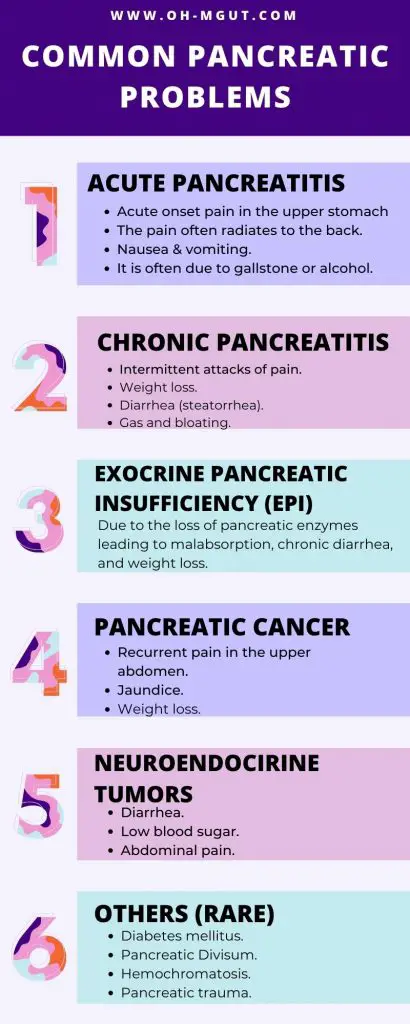Pancreas Problems: 5 Main Conditions, Symptoms, & Signs
Our content is not intended nor recommended as a substitute for medical advice by your doctor. Use for informational purposes only.
The pancreas is a small organ in the upper left abdomen (just below the stomach). It has various functions, such as digestion and blood sugar regulation.
Acute pancreatitis, chronic pancreatitis, pancreatic cancer, pancreatic neuroendocrine tumors, and exocrine pancreatic insufficiency are some of the most common problems with the pancreas.
There are also some rare problems with the pancreas, such as pancreatic divisum, trauma, and a problem with the sphincter of Oddi.
Today, you will learn about these common pancreatic problems, their symptoms, and their signs.
Common pancreas problems:
- Acute pancreatitis.
- Chronic pancreatitis.
- Exocrine pancreatic insufficiency.
- Pancreatic cancer.
- Pancreatic neuroendocrine tumors (NETs).
- Other problems include diabetes mellitus, pancreatic trauma, sphincter of Oddi dysfunction, etc.
Table of Contents

1. Acute pancreatitis (The most common Pancreas problem).
The pancreas releases digestive enzymes to breakdown and digest food. When it inflames, the digestive enzymes start digesting the pancreas itself.
Pancreatitis can be acute or chronic. Both forms lead to sharp upper stomach pain. Pancreatitis can lead to serious complications if left undiagnosed or untreated.
Most cases of pancreatitis are caused by a blockage of the pancreas’s duct by a stone, drinking too much, or having too many lipids (triglycerides) in the blood.
Symptoms (how to suspect pancreatitis).
- The main symptom is sharp abdominal pain in the upper central stomach area.
- The pain starts as dull, boring, and steady. Then, the pain gradually intensifies until reaching a constant sharp ache.
- The pain is usually referred to the middle back (in approximately 50% of cases).
- The pain becomes less intense on leaning forward.
- The pain intensity may increase after lying on the left or the right side (depending on which part of the pancreas is involved).
- Pancreatitis pain is associated with severe nausea, vomiting, and lost appetite.
- Eating dramatically worsens the condition.
- A history of gallstones, alcoholism or increased blood lipids (triglycerides) increases the odds of pancreatitis.
- Fever is common with acute pancreatitis.
Caution: Pancreatitis is a medical emergency. Seek emergency medical help if your symptoms are suspicious of pancreatitis.
2. Chronic pancreatitis.
Another common pancreas problem is a chronic inflammation of the pancreas or chronic pancreatitis. Chronic inflammation and destruction of the pancreas occur for various reasons, such as:
- Chronic alcoholism.
- Pancreatic duct obstruction by a stone, tumor, or trauma.
- Cystic fibrosis.
- Hereditary pancreatitis.
- Drugs such as chemotherapy.
- Autoimmune diseases such as SLE.
- Autoimmune pancreatitis.
Symptoms of chronic pancreatitis:
- Intermittent attacks of abdominal pain over a long period. The pain is usually m derate to severe but less severe than the pain of acute pancreatitis.
- The pain is in the upper central abdomen (epigastric area).
- Some patients may not have pain at all. For example, only 77% of patients with alcohol-induced chronic pancreatitis experience pain (reference).
- Chronic diarrhea or steatorrhea (may be greasy or oily and offensive in severe cases).
- Gas and bloating.
- Weight loss due to malabsorption.
Diagnosis of chronic pancreatitis:
- Abdominal CT or MRI.
- A special type of MRI (secretin-stimulated MRCP).
- Blood (serum) lipase and amylase levels are often slightly elevated.
- Low serum Trypsin.
- Stool tests such as fecal chymotrypsin and pancreatic elastase one.
3. Exocrine pancreatic insufficiency (EPI).
Your pancreas secretes enzymes that digest food. For example:
- Lipase e zymes: help fat digestion.
- Amylase enzyme: helps carbohydrate digestion.
- Protease enzyme: help protein digestion.
Your pancreas won’t make enough of these enzymes if something goes wrong. This makes it hard to digest food, which can cause problems like diarrhea after eating fatty foods (like when you don’t have enough lipase) and constant stomach pain.
The conditions that may lead to Exocrine Pancreatic Insufficiency (EPI) include: (reference)
- Chronic pancreatitis: recurrent inflammation and damage to the pancreas lead to permanent loss of the cells secreting pancreatic enzymes. One of the most common causes of chronic pancreatitis is alcoholism.
- A rare condition called cystic fibrosis is an inherited genetic disease that affects the lungs and the digestive and reproductive systems and leads to pancreatic insufficiency.
- Operative resection of parts of your small intestine, pancreas, and stomach.
- Obstruction of the pancreatic duct.
- Other diseases are affecting the pancreas (rare): such as hereditary hemochromatosis and Shwachman-Diamond syndrome.
Symptoms (how to suspect?)
- Mild diseases may have no symptoms at all. Or it may have mild s symptoms such as abdominal discomfort and mild diarrhea after eating fatty foods, carbohydrates, or proteins.
- Moderate to severe disease: Maldigestion and diarrhea after eating fatty foods, carbohydrates, and proteins.
- Fatty diarrhea with loose greasy stool: occurs in severe cause with loss of more than 90% of pancreatic function.
- Bloating, flatulence, stomach cramps, and weight loss.
- Other symptoms of chronic pancreatitides, such as recurrent mid-epigastric pain, may be present.
4. Pancreatic cancer (The most serious pancreatic problem).
Pancreatic cancer is considered the most lethal pancreatic problem. It is one of the deadliest cancers, with one of the lowest survival rates.
The five-year survival rate for pancreatic cancer is about 7.2% (reference). Unfortunately, pancreatic cancer is the fourth leading cause of cancer-related death in the United States.
Symptoms of pancreatic cancer:
- Chronic or recurrent pain in the upper central part of the abdomen.
- Weight loss.
- Generalized weakness.
- Anorexia (lack of appetite).
- Dark urine, jaundice, and clay-colored stools.
- Nausea or vomiting.
- Diarrhea.
- Back pain.
- Steatorrhea (fatty diarrhea).
Diagnosis of pancreatic cancer.
Pancreatic cancer is thought to be present in anyone who has stomach pain, loses weight, stops eating, or gets jaundiced.
Investigations may include:
- Laboratory testing includes Bilirubin levels, Alkaline phosphatase, liver enzymes, amylase, lipase, and full blood count.
- Abdominal ultrasound.
- Abdominal CT (contrast-enhanced).
- Endoscopic ultrasound.
- Others, such as MRI, PET scans, etc.
Conclusion:
Pancreatic cancer is a serious pancreas problem that needs to be spotted early. Suspect pancreatic cancer if there is chronic abdominal pain, weight loss, and fatigue.
5. Pancreatic Endocrine neuroendocrine) tumors.
Pancreatic neuroendocrine tumors (NETs) arise from hormone-secreting cells in the pancreas. These neuroendocrine tumors produce excess hormones according to their type, leading to various symptoms.
FACT: Steve Jobs died due to a pancreatic neuroendocrine tumor.
Although it is a rare pancreas problem, pancreatic NETs may lead to various symptoms related to the secreted hormones and the tumor mass inside the pancreas.
Common pancreatic neuroendocrine tumors:
| TUMOR | HORMONE SECRETED | Symptoms |
|---|---|---|
| Insulinoma | Insulin (lowers blood glucose). | Attacks of sudden irritability, sweating, and numbness may lead to coma (due to low blood glucose). |
| Zollinger-Ellison Syndrome | Gastrin (increases blood glucose). | Abdominal pain, peptic ulcer symptoms, reflux symptoms, diarrhea. |
| VIPoma | VIP (Vasoactive intestinal peptide). | Diarrhea, dehydration, fatigue, and weakness. |
| Glucagonoma | Gurgaon | Rash, weight loss, sugar (glucose) intolerance. |
| Somatostatinoma | Smatostate. | Diabetes, gallbladder stones, diarrhea. |
6. Other pancreas problems.
- Diabetes mellitus: is considered a pancreatic problem as it is mainly caused by the decline in insulin production by the pancreas.
- Pancreatic divisum: a birth defect in the pancreas leading to abnormal pancreatic juice drainage and pancreatitis.
- The sphincter of Oddi dysfunction is a spasm in the muscle ring surrounding the common opening of the pancreas and bile duct into the duodenum. This mainly leads to biliary colics (and sometimes, pancreatic pain).
- Hemochromatosis is a condition in which iron deposits in the pancreas (mainly due to chronic hemolytic anemias) lead to pancreatic failure (exocrine pancreatic insufficiency), pancreatitis, or diabetes.
- Pancreatic trauma (during surgery or major trauma such as road traffic accidents).
- Pancreatic pseudocyst: a complication of acute pancreatitis.
- Evidence-based
- Written by a doctor.












